As I preannounced here, I would have been quite happy to score 4 points in the nine games. This came after realizing that the median rating of the players was in the 2300s. As for mine, because of a series of events (among which my absence from competitive chess for almost a decade) it was the fourth lowest among the participants, at 1899; however I held the opinion that my strength is in the upper 2000's, and the results of this tournament do confirm my idea.
So what did I do ? I ended at 4.5 points, with two wins, two losses, and five draws. Beyond my wildest dreams! What is more important is that my performance rating in the nine games is well above 2100. Also worth noting is that I won the first prize for my Elo range (players with Elo<2000). Here are the details of my opponents and score:
Round 1: Dorigo - Sibilio (FM, 2349) 1/2
Round 2: Santolini (M, 2144) - Dorigo 1/2
Round 3: Dorigo - Massironi (M, 2245) 0-1
Round 4: Tsalughelashvili (WFM, 2080) - Dorigo 1/2
Round 5: Dorigo - Parrella (2075) 1/2
Round 6: Gallo (M, 2079) - Dorigo 1-0
Round 7: Dorigo - Giuriato (1959) 1/2
Round 8: Bozzao (1859) - Dorigo 0-1
Round 9: Lantini (M, 2189) - Dorigo 0-1
So it was by winning the last two games with the black pieces that I reached the 50% score. Perhaps the most interesting game I played was indeed the one I played in the last round, against Marco Lantini, a master from Rome. I report the game below, with some commentary.
Here is my last round game:
Lantini-Dorigo, December 23rd 2012
Città di Padova, round IX
1. d4 d5
2. c4 Bf5
The Keres defence, a rarely played system with which black attempts a radical solution to the problem of development of the light-squared bishop. It is a perfectly sound opening in my humble opinion...
3.Nd2
Out of theory at move 3! My opponent evidently decided to avoid the main lines of this setup, which he reasoned I should know better than him.
3.... e6
4.Ngf3 Nf6
5.g3 c6
6.Bg2 Bd6
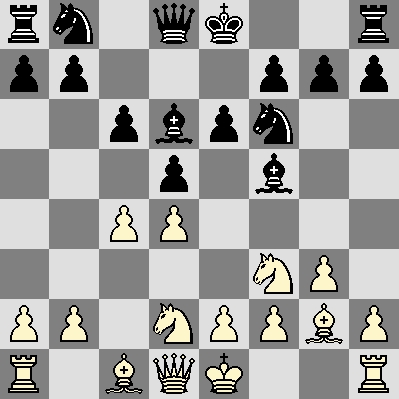
Black has no problems. According to Fritz 8 here it was slightly preferable to play 6....Be7 7.0-0 0-0 8.b3 a5 9.a3 Ne4, with a slight preference for black.
7.Nh4 Bg4
8.Qc2
Here white should have preferred 8.Qb3 Qc7 9.h3 Bh5 10.g4 Bg6 11.Nxg6 hxg6, with a balanced position.
8.... Nbd7
9.e4 ?
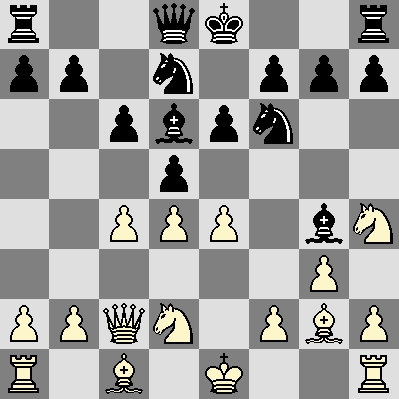
The first real inaccuracy. This central push is premature: white has weak central pawns and a decentralized knight that becomes a target.
9....dxe4
10.0-0
Now was the time to take advantage of white's inaccurate play: 10....g5!, to which a practically forced variation develops: 11.Nxe4 Nxe4 12.Qxe4 Nf6 13.Bxg5 Nxe4 14.Bxd8 Rxd8 15.Bxe4 Be7, and here black is a pawn down but the central pawn in d4 must fall, giving him an edge. For example 16.Nf3 f5!? 17.Ne5 Rxd4 with a slight plus for black.
Note that the intermediate castling of white after 9....dxe4 is an implicit exchange sacrifice, but black would be ill-advised to accept it: on 10.0-0 Be2? follows 11.Nxe4 (hitting both the Be2 and the Bd6!) Bxf1 12.Nxd6+ Ke7 13.Nxb7 Qc7 14.Kxf1 Qxb7 15.Qa4!, and white has a bishop and pawn for the rook, plus a strong initiative on the weakened black queenside.
10....0-0
Unfortunately I decided to play more simply than 10....g5!, because I did not see an advantage in the opposite-coloured bishop ending that would end up developing in the aforementioned variation.
11.Nxe4 Nxe4
12.Bxe4 Nf6
defending h7 and threatening to exchange white's dear light-squared bishop...
13.Bg2 Rc8
Now the idea of black is to push e6-e5, preventing the subsequent d4-d5 by white by tactical means (the white queen would end up in the same open file as the black rook).
14.Re1 Re8
15.Bd2
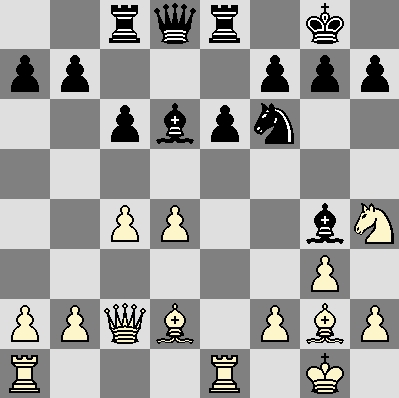
Now indeed black could have pushed: 15....e5!?. However this would lead to a still balanced position after 16.h3 Bh5 17.Qb3 b6 18.g4 Bg6 19.Nxg6 hxg6 20.dxe5 Bxe5 21.Rad1 Qc7.
15.... Qc7
16.Bg5 Be7
17.Bf4 Bd6
18.Be5 Nd7!
19.Qe4 f5!?
The last move by black was not strictly needed: I could have rather played the simple 19... Bh5 20.Bxd6 Qxd6, with an even position.
20.Qe3?!
But here it is white who plays an inferior move. 20.Bxd6 was better.
20.... Nxe5!
21.dxe5 Ab4
22.Reb1 Qa5
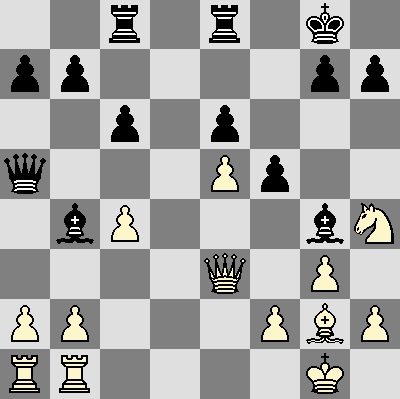
Here I offered a draw. Objectively the position is balanced, but the
master of course wanted to win against a lower-rated opponent. So he
refused. He should have known better...
23.h3 Bc5!?
With this move black steps into a very complex endgame, objectively still balanced but very difficult to play for both players! Given that I would have been happy with a draw I should have rather chosen the smarter 23....Bd2!, which gives black an additional option with respect to the variation that develops in the game: 24.b4 Qd8! (24....Bxe3 is back into the game continuation) 25.Qxa7 Be2 and black has a very dangerous initiative for the pawns: for instance 26.Qxb7 Bc3 27.Bxc6 Re7 28.Qa6 f4! 29.Kg2 fxg3 30.fxg3 Rb8 31.Bf3 Qd2 and white is in dire straits.
24.b4!? Bxe3
25.bxa5 Bd4
26.hxg4 fxg4
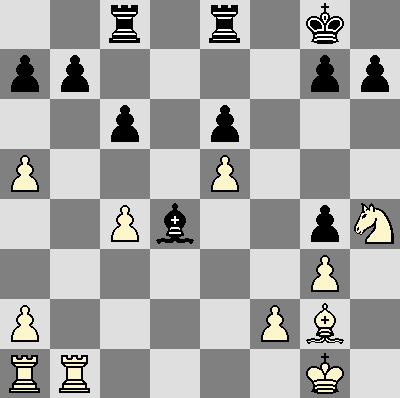
As a consequence of the last few forced moves, black has lost a bishop for a pawn; however he will soon win also the e5 pawn, and then trade his remaining bishop for the Ra1. The material will be roughly balanced, but black has active play with his rooks.
27.Bf1
Otherwise 27.... g5! wins the white knight.
27...Bxe5
28.Ng2 Rcd8
29.Ne3 h5
30.a4?!
White wants to free his rook and forces the events, but he should have rather waited and played 30.c5! Rf8 31.Bc4 Kh8 32.Bxe6 Rf6 33.Bc4 Rdf8 with an unclear position.
30... Bxa1
31.Rxa1 Rd2
32.Rb1 Re7?!
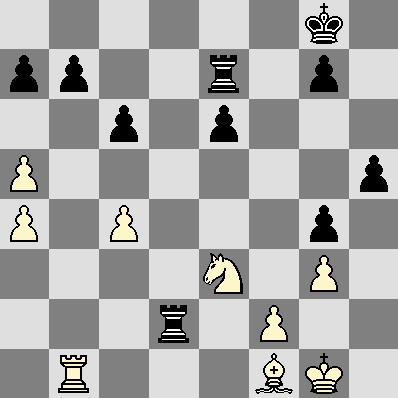
Inaccurate play by black! The rook is needed on the f file, even at the cost of the queenside pawns! In endings of this kind, the activity of the rooks is of paramount importance...
33.c5 Kf7?!
Again inaccurate. Better 33... Kf8! with a unclear position.
34.Nc4 Ra2
35.Rb4?!
White also falters. The variation 35.Nd6+ Kf6 36.Nxb7 e5 37.Nd6 e4 would have given him the edge.
35....g5
36.Nd6+ Kf6!
37.Nxb7 h4
Black tries to activate his kingside pawns and create threats to the black king. This is sufficient to maintain the balance, but here both players are very short of time (the time control foresaw 40 moves in 90 minutes with 30 second increments, and then 30 more minutes allocated at move 41).
38.Nd6 h3?
Black fails to find the correct move. 38....Ra1! 39.gxh4 gxh4 40.Rxg4 Rh7 was sufficient for a draw.
39.Rxg4?
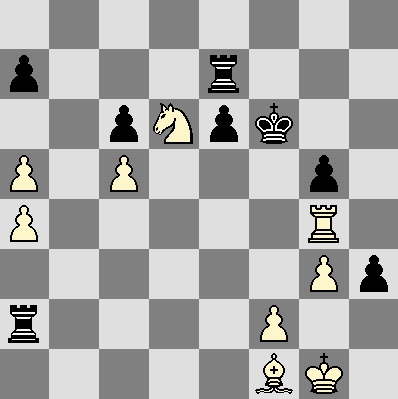
And white also falters! With 39.Bd3! he would have freed his pieces with a clear edge.
39....Rh7!
Now black is on top! And accurate play is still needed for white, to avoid a catastrophic bind...
40.f3?
The final mistake! With 40.f4! h2+ 41.Kh1 Ra1 42.fxg5+ Kg6 43.Rf4 Re1 the position is drawn. I believe white played f3 to try and trick black into a mate net...
40.... h2+
Now white is lost.
41.Kh1 Ra1
White cannot untie itself without losing a piece now
42.Ne4+
Hoping in 42....Kf5?? 43.Rxg5 mate!
42....Ke7
43.Nd2 Rd1
44.Rd4 e5
45.Rd6 Rh8
With a simple plan: exchange the rook and win a piece, whereby the ending will be won. White cannot avoid it!
46.a6
White could have tried to keep his rook, playing 46.g4 Rb8 47.Nc4 but after e.g. Rxf1+ 48.Kxh2 Rc1 49.Ne3 Rxc5 50.Nf5+ Ke8 51.Kg3 Rb4 52.Rg6 Rxa4 53.Rxg5 Rcxa5 black is winning.
46....Rd8
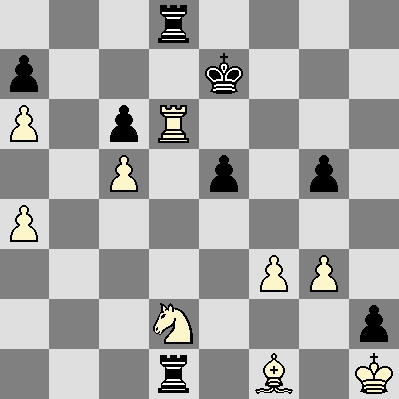
Consistently carrying out the winning plan. Of course I could have tried also 46....g4 47.fxg4 e4 48.Rd4 e3 49.Re4+ Kf6 50.Rxe3 Rxd2, but I reasoned that I ran fewer risks by taking off the board the last of white's rooks.
47.Nc4 Rxf1+
48.Kxh2 Rxd6
49.cxd6+
Taking with the knight would not change matters: 49.Nxd6 Rxf3 50.Nc8+ Kd7 51.Nxa7 e4 52.Nb5 cxb5 53.a7 Rf8 and the e pawn promotes.
49....Ke6
50.Kg2 Ra1
51.a5 Ra4
52.d7 Kxd7
53.Nxe5+ Kc7
The plan is simple: black will push his passed pawns supporting them with the king. At the right moment the exchange of the knight with the rook will be unavoidable, with an easy win.
54.Kh3 c5
55.Kg2 Rxa5
56.Rf2 Rxa6
57.Nf7 Rg6
58.Ke3 Rg7
59.Nh6 Kc6
60.Kd3 Kb5
61.Nf5 c4+
And white finally resigns. A tough game with a tough opponent, which gave me a deep satisfaction to win!





Comments